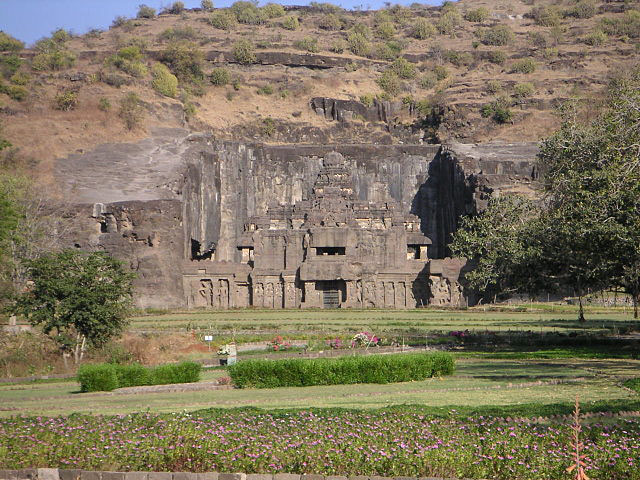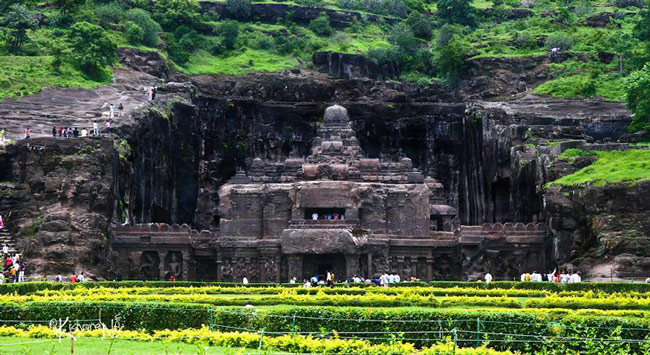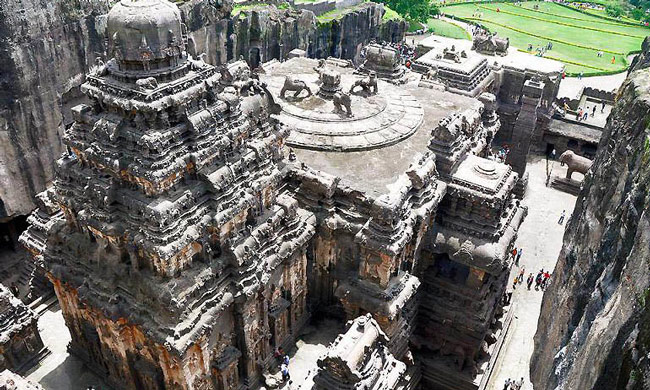Ellora cave complex - India
Unesco's Scientific, Educational and Cultural Organization has recognized India's Ellora Cave Complex as a World Cultural Heritage in 1983.
Ellora Caves - World Cultural Heritage in India
Located on the hills of Charanandri , about 30 km from the Indian city of Auranqabad, Ellora cave complex is the ideal destination for travelers who like to learn the unique stone carving architecture of ancient people in South Asia.

The most outstanding feature and leaving the most impressive in the entire Ellora cave complex is the religious buildings designed and built in the architectural style carved on monolith. The cave complex has all 34 temples and monasteries of Buddhism, Hinduism and Jainism. In particular, Buddhist cave consists of 12 works, numbered from number 1 to number 12, Hindu caves including 17 works (cave number 13 - 29), and the cave of Giai Nam Giao consists of 5 works (cave) number 30 - 34). These ancient architectural works were built in the V century - the Xth century. These are vivid proofs for the flourishing period of the above religions in Indian history at that time.

The most prominent building in the Buddhist cave complex in Ellora is the number 5 cave known as Kailash . Cave No. 5 has a depth of 35.66 m and a width of 17 m, with a corridor surrounding it and 24 stone columns supporting the ceiling. On the walls are carved statues of bodhisattvas, patterns, motifs are also very sophisticated and lively. Historians and scientists argue that the Buddhist caves in Ellora were built by the people who left Ajanta for some unknown reason. However, the Buddhist caves in Ellora are less attractive to tourists than in Ajanta because the caves here are so big, the works are scattered but not gathered at one place, which hampers sightseeing. Tourists who come here often tend to go straight to Kailash and visit only in that cave.

Cave No. 16 is considered the main point of the entire ancient architecture at Ellora, this is the Hindu cave. Dynamic is designed from top to bottom and from outside to inside. The main part of this structure is the temple in the middle that is carved apart from the surrounding mountain. Historians believe that this temple was carved over ten generations and it took 200 years to complete. Artistic sculptures done in many stages and through various kings are truly completed and look like they are today.

If you visit this cave complex, visitors will be really overwhelmed by its grandiose and large scale. Symmetrically on both sides of the temple are two pillars and two majestic stone elephants. The center is a typical temple of Hinduism with a floor on Linga altar. The back of the temple is a series of stone elephants as a pedestal for the temple above. The walls of the cliffs surrounded by two-storey gallery rooms. All architectural items here are extremely wonderful, demonstrating the peak level of Indian stone carving art.

Located separate from the population of Buddhist and Hindu mosques is quite far from the four-cave system of Judaism. Cave No. 32 is the most prominent cave among the four caves there. The structure of this Judaism temple is no different from the Kailasha temple of Hinduism. In front of the main hall worship a Jude Saint with many unique sculptures. Leaning to one side of the neck of the tower is a pillar and a stone elephant instead of each pair carved symmetrically like Kailasha temple .
Ellora Cave Complex is an architectural work that best represents the historical period Mohammd Bin Tughlak - ruler in Delhi, India in the 14th century. All 34 caves in Ellora are carved into the hills about 2 km, the inside structure of the cave is quite complex with the corridors and upstream passages. Some caves have 2 floors or 3 floors and have separate corridors. The overall architecture of the cave architecture in Ellora creates a beautiful picture, giving people a feeling of peace when visiting this place.

Because of Ellora's historical values and marvelous architectural works, this monument was recognized as a world cultural heritage in 1983 by Unesco. In 1983, India had all four recognized legacy. , Ellora cave complex is one of the 4 heritage sites and is a place that cannot be visited when you arrive in India.














- Mysterious temple in India is carved from a single stone block
- Discover beautiful cave in Quang Binh
- Ajanta cave temple - India
- 8 interesting facts about Son Doong cave
- Hang Son Doong is a record holder of 3 world records
- Picture drawing aliens on the cave
- Famous caves in the world
- The cave is larger than Son Doong
- Discovering a mysterious cave cave population
- 57 newly discovered caves in Quang Binh
- Hai Duong: Discovering an ancient tomb in a cave over 3,000 years old, there are many remains
- Mysterious handprints in ancient cave
 Suzhou classic bonsai garden - China
Suzhou classic bonsai garden - China Chau Nguyen Dynasty
Chau Nguyen Dynasty Thai Son Mountain - World Wonder
Thai Son Mountain - World Wonder Ancient villages of Shirakawa-go and Gokayama
Ancient villages of Shirakawa-go and Gokayama